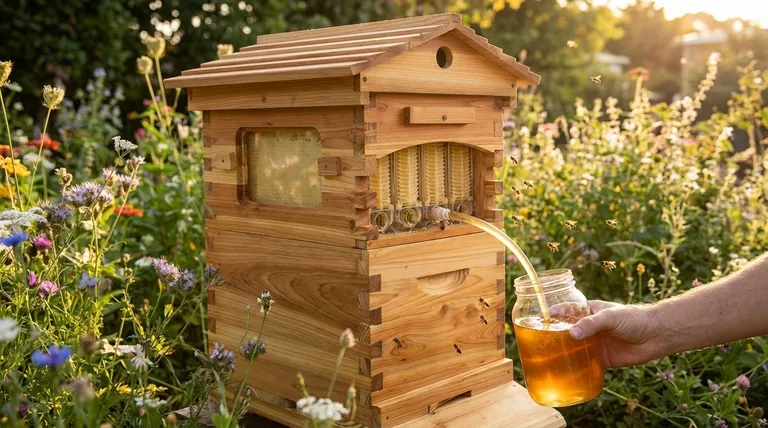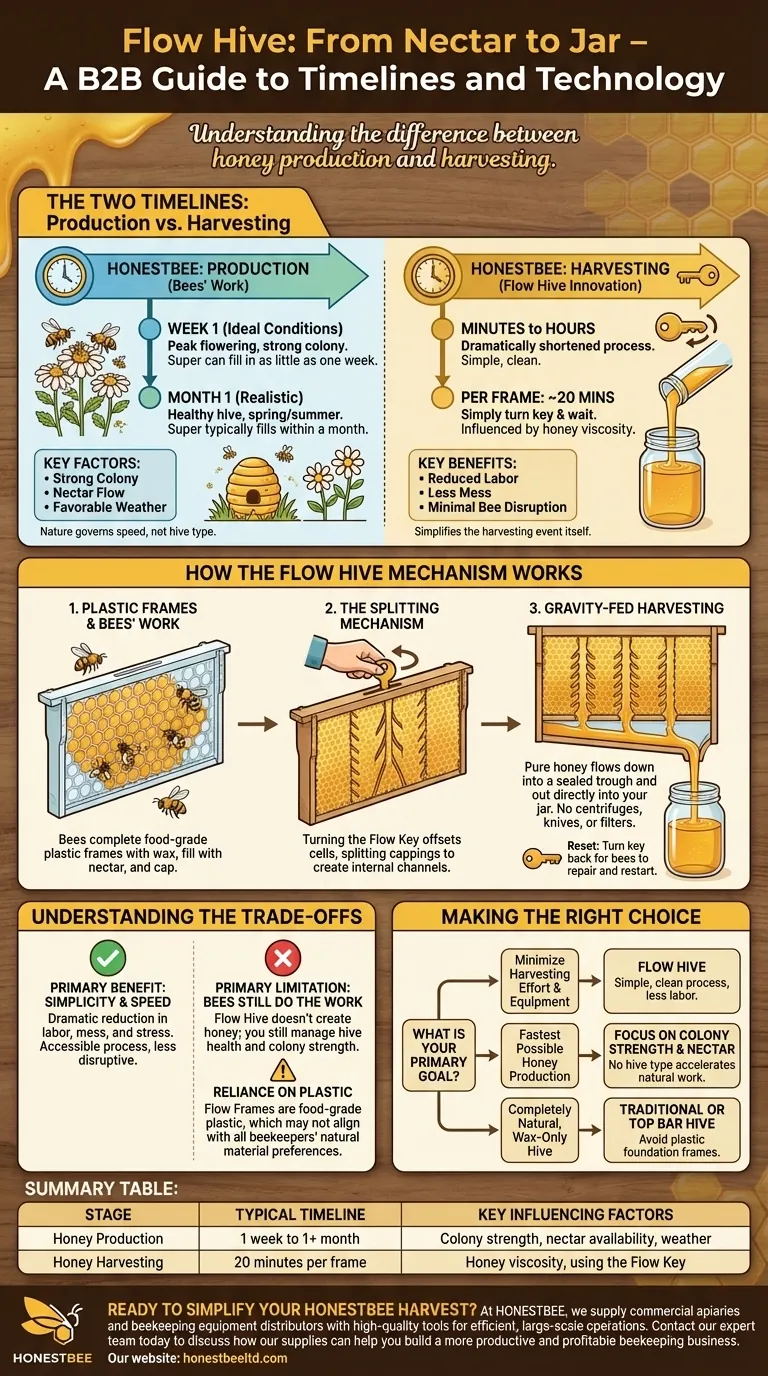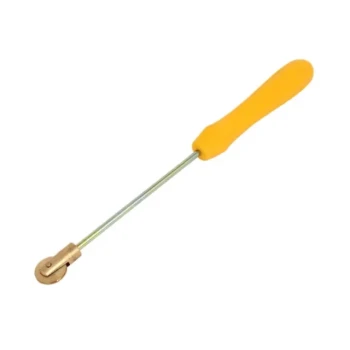Under ideal conditions, a Flow Hive super can fill with honey in as little as one week. This typically occurs during the peak of the flowering season with a very strong, established colony. A more realistic expectation for a healthy hive during the spring and summer is for the super to fill within a month.
The time it takes for bees to produce honey depends entirely on the strength of your colony and the availability of nectar, not the type of hive. The Flow Hive's true innovation is not in speeding up honey production, but in dramatically simplifying and shortening the harvesting process itself.

The Two Timelines: Production vs. Harvesting
To understand the timing, it's critical to separate the process into two distinct phases: the bees' work (production) and the beekeeper's work (harvesting).
The Honey Production Timeline (Weeks to Months)
This phase is governed by nature, not technology. The speed at which your bees make honey is determined by several key factors.
A strong nectar flow, healthy bee population, and favorable weather are the true drivers of honey production speed. The hive is simply the structure the bees use.
The Honey Harvesting Timeline (Minutes to Hours)
This is where the Flow Hive fundamentally changes the equation. Traditional honey harvesting is a labor-intensive, multi-hour process involving specialized equipment.
The Flow Hive reduces this entire process to a few simple steps. You simply turn a key and wait for the honey to drain directly into your jars. The harvesting event for a single frame can be completed in as little as 20 minutes, though it may take longer depending on the honey's viscosity.
How the Flow Hive Mechanism Works
The speed and ease of a Flow Hive harvest are made possible by its unique frame technology.
Partially-Formed Plastic Frames
The system uses specially designed frames made from BPA and BPS-free, food-grade plastic. These frames contain partially formed honeycomb cells.
The bees complete the cells with their own wax before filling them with nectar and capping them with more wax, just as they would in a traditional frame.
The 'Splitting' Mechanism
Once you've determined the honey is ready via the observation windows, you insert the Flow Key into a slot at the top of the frame and turn it 90 degrees.
This action offsets the cells vertically, splitting the wax cappings. This creates channels inside the comb, allowing the pure honey to flow downward, protected from the bees.
Gravity-Fed Harvesting
The honey flows through these channels into a sealed trough at the bottom of the frame and out through a tube, directly into your collection jar. No centrifuges, uncapping knives, or filters are required.
After the honey has drained, you turn the key back to its original position. This resets the cells, allowing the bees to repair the comb and begin the process again.
Understanding the Trade-offs
While the harvesting method is revolutionary, it's important to have a balanced perspective.
The Primary Benefit: Simplicity and Speed
The undeniable advantage is the dramatic reduction in the labor, mess, and stress of harvesting. It eliminates the need for expensive extraction equipment and makes the process accessible to almost anyone. It is also far less disruptive to the bees.
The Primary Limitation: The Bees Still Do the Work
A Flow Hive does not create honey; the bees do. You are still responsible for all other aspects of beekeeping, including managing hive health, performing inspections, and ensuring the colony is strong enough to produce a surplus of honey.
Reliance on Plastic Components
The Flow Frames are made of plastic. While it is high-quality, food-grade material, some beekeepers have a philosophical preference for using only natural materials like wood and beeswax in their hives. This is a key point of consideration.
Making the Right Choice for Your Goal
Your beekeeping goals should dictate whether the Flow Hive is the right tool for you.
- If your primary focus is minimizing harvesting effort and equipment: The Flow Hive is designed specifically for this, turning a complex, multi-hour job into a simple, clean process.
- If your primary focus is the fastest possible honey production: Your efforts should be on building a strong colony and ensuring access to abundant nectar, as no hive type can accelerate the bees' natural work.
- If your primary focus is a completely natural, wax-only hive: You will likely prefer a traditional Langstroth or Top Bar hive that does not rely on plastic foundation frames.
Ultimately, understanding the distinction between honey production and honey harvesting is the key to setting the right expectations for your beekeeping journey.
Summary Table:
| Stage | Typical Timeline | Key Influencing Factors |
|---|---|---|
| Honey Production | 1 week to 1+ month | Colony strength, nectar availability, weather |
| Honey Harvesting | 20 minutes per frame | Honey viscosity, using the Flow Key |
Ready to simplify your honey harvest?
At HONESTBEE, we supply commercial apiaries and beekeeping equipment distributors with the high-quality tools needed for efficient, large-scale operations. Whether you manage a traditional setup or are considering innovative systems like the Flow Hive, we provide the durable, wholesale-focused equipment to support your success.
Contact our expert team today to discuss how our supplies can help you build a more productive and profitable beekeeping business.
Visual Guide

Related Products
- Automatic Honey Flow Beehive 4 Frame Mini Hive for Beekeeping
- HONESTBEE Advanced Ergonomic Stainless Steel Hive Tool for Beekeeping
- HONESTBEE Professional Long Handled Hive Tool with Precision Cutting Blade
- Professional Dual-End Stainless Steel Hive Tool for Beekeeping
- Professional 3-Bar Frame Grip with Integrated Hive Tool
People Also Ask
- What are the advantages of using an Auto Flow Hive? Experience Gentle, On-Tap Honey Harvesting
- How does the Flow Hive simplify honey harvesting? The Revolutionary 'Honey on Tap' System Explained
- What are the advantages of using a Flow Hive? Simplifying Harvesting for Modern Beekeepers
- What are the benefits of using the Flow Hive for honey harvesting? Simplify Your Harvest & Protect Your Bees
- How long does it take for bees to fill a Flow Hive? A Guide to Realistic Timelines



















